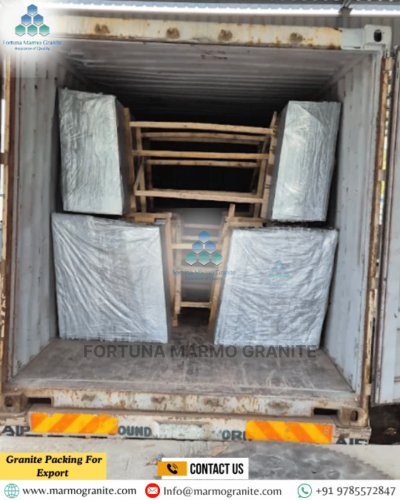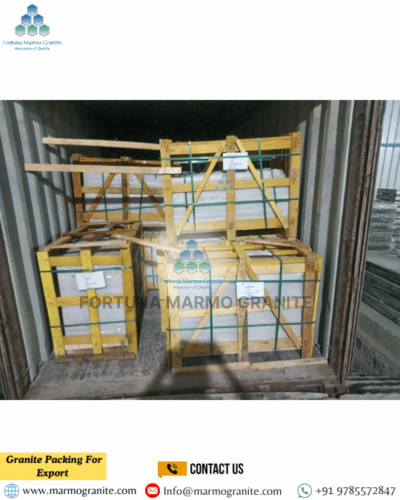Packaging Granite for Export: Choosing Between Crates, Pallets, and Containers
Packaging Granite for Export The journey of granite from rugged mountain quarries to shining showrooms worldwide is truly remarkable. People admire granite for its natural beauty and strength, making it a top choice for homes and commercial projects. Exporters also focus on the process that prepares granite for export. They treat packaging as a crucial step to deliver stone safely, protecting it from long travel, changing weather, and multiple handling stages. Exporters carefully select the right packaging based on the stone's size, finish, mode of transport, climate conditions, and destination rules.
Wooden crates provide strength and flexibility, making them ideal for safeguarding individual slabs or tiles, especially during long sea shipments. Pallets offer a cost-effective way to transport larger quantities, but they need extra padding and reinforcement to protect edges and surfaces from damage. Containers add the final layer of protection, keeping the packaged stone safe from moisture, weather, and heavy stacking during transit. Without proper packaging, granite can develop cracks, chips, or moisture stains—issues that cause financial losses and damage a brand's reputation. That's why packaging goes beyond wrapping stone; it plays a vital role in preserving quality.


The Unique Challenges of Exporting Granite
- Weight – Granite's high density demands strong packaging that withstands heavy pressure. Exporters also use specialized handling equipment at every transport stage. Since weight affects shipping costs, efficient space utilization becomes essential.
- Brittleness – Even though granite is very hard, it can be brittle. Rough handling or strong impact may cause chipping, cracking, or edge breakage. Exporters add extra protection to prevent such damage.
- Surface Vulnerability – Polished granite surfaces easily pick up scratches, marks, or abrasions. Dust, grit, or even minor contact can harm the finish, so coverings and separators keep the stone pristine.
- Irregular Shapes and Sizes – Along with standard slabs, many exports include custom cuts, tiles, or irregular designs. These require tailored packaging solutions that provide stability, protection, and safe delivery.
- Moisture Sensitivity – While granite resists water naturally, prolonged exposure can lead to stains, mold, or mildew, especially on unsealed surfaces. Exporters protect shipments with moisture-proof packaging and separators.
- Customs and Regulations – Exporters must follow strict customs rules, import duties, and phytosanitary standards for wooden packaging. Non-compliance or incorrect paperwork may cause delays, fines, or shipment rejection.
Packaging Options: A Detailed Look
- Crates: The Ultimate Protection
Crates are robust, enclosed wooden structures designed to fully encase and protect their contents. They are often custom-built to fit the specific dimensions of the granite pieces.
Advantages:
- Superior Protection: Crates shield granite pieces from impact, abrasion, and compression on all sides, making them ideal for fragile, valuable, or uniquely shaped items.
- Security: Their fully enclosed design blocks theft and tampering effectively.
- Stackability (Conditional): With strong internal support, well-built crates allow safe stacking to save container space.
- Weather Protection: Proper sealing and lining keep granite safe from moisture, dust, and harsh environmental conditions.
- Customization: Exporters can tailor crates with bracing, foam inserts, or special compartments to secure each piece and prevent shifting during transport.
Disadvantages:
- Cost: Crates are generally the most expensive packaging option dueu to the materials and labor involved in their construction.
- Weight and Volume: They add significant weight and bulk to the shipment, increasing freight costs.
- Labor Intensive: Packing and unpacking crates can be more labor-intensive and require specialized equipment.
- Environmental Impact: While wood is a renewable resource, the sheer volume of material used can be a concern for some, and proper disposal/recycling is necessary.
When to Choose Crates:
- For high-value, highly polished, or intricately cut granite slabs and unique architectural pieces.
- When shipping to destinations with rough handling or less developed infrastructure.
- For extremely delicate or irreplaceable granite items.
- When maximum protection against theft and environmental factors is paramount.
2. Pallets: Versatility and Efficiency
Advantages:
- Cost-Effective: Pallets are generally less expensive than crates, especially for standardized slab sizes.
- Ease of Handling: They are designed for efficient loading and unloading with standard material handling equipment.
- Space Optimization: Vertically oriented A-frame pallets are excellent for maximizing container space when shipping multiple slabs.
- Ventilation: The open nature of many pallet designs allows for better air circulation, which can be beneficial in certain climates to prevent condensation (though protection from direct rain is still crucial).
- Less Weight and Volume: Compared to crates, pallets add less weight and volume to the shipment.
Disadvantages:
- Less Protection: Pallets offer less comprehensive protection than crates, leaving granite exposed to potential impacts from the sides and top.
- Vulnerability to Moisture and Dust: Unless covered and shrink-wrapped, granite on pallets is more susceptible to dust and moisture damage.
- Security: Goods on pallets are more exposed, making them potentially more vulnerable to theft or tampering.
- Stackability (Limited): While individual pallets can be stacked in a warehouse, stacking laden granite pallets during transit often requires careful consideration of weight distribution and structural integrity.
3. Containers: The Encompassing Solution
Advantages:
- Economy of Scale: Exporters save significantly by shipping full containers, making this option the most cost-effective for large granite volumes.
- Environmental Protection: Containers shield granite from harsh weather, dust, and environmental exposure throughout transit.
- Security: Sealed containers provide strong protection against theft and tampering, ensuring safe delivery.
- Standardization: Designed for intermodal transport, containers move seamlessly between ships, trains, and trucks, ensuring efficiency and reliability.
Disadvantages:
Exporters treat internal securing as a top priority because proper dunnage, bracing, and fastening of crates or pallets keep granite stable during transit and prevent severe damage. Careful planning and execution at this stage eliminate costly risks. Standard dry containers also face challenges like temperature fluctuations and condensation, often referred to as "container rain." To overcome this, exporters rely on ventilation systems, desiccants, or specialized container liners that protect granite surfaces from moisture. At the same time, exporters pay close attention to container weight limits. While containers can hold substantial loads, overloading may cause penalties and safety hazards. By maintaining correct weight distribution inside the container, exporters ensure safe, efficient, and damage-free transportation of granite.
When to Utilize Containers:
- Almost always, as containers are the standard for international freight. The choice then becomes how the granite is packaged within the container.
- For large-volume shipments that justify a full container load (FCL).
- When shipping to distant international destinations.
Critical Considerations for All Packaging Types
Regardless of whether you choose crates, pallets, or a combination within containers, several universal considerations are paramount:
Internal Protection and Dunnage: Proper internal support is essential when transporting granite. Use ample padding materials such as foam, corrugated cardboard, or custom-cut wooden blocks to fill voids, absorb shocks, and prevent movement. For polished slabs, interleave protective sheets (plastic film, soft foam, or felt) between each piece to avoid scratches.
Moisture Control:
Desiccants: Place silica gel or clay desiccant packets inside crates or around palletized granite to absorb moisture during long or humid transits.
Vapor Barrier Liners: Encapsulate granite with vapor barrier bags or liners to prevent moisture ingress in sealed crates or pallets.
ISPM 15 Compliance (for Wood Packaging)- If solid wood packaging materials such as crates, pallets, or dunnage are used, they must comply with ISPM 15 international standards. This ensures the wood is treated and properly marked to prevent the spread of pests. Non-compliance can result in shipment rejections, costly delays, re-export, or even destruction of goods. To avoid risks, always source packaging from ISPM 15 certified suppliers.
Labeling and Documentation
Clear, accurate labeling is essential for smooth handling and customs clearance. Each package should include:
- "Fragile" and "Handle with Care" markings.
- "This Side Up" arrows.
- Weight details (gross and net).
- Consignee and shipper information.
- Destination port and final delivery address.
- Hazard symbols, if applicable (rare in the case of granite).
Conclusion
Indian Granite Supplier Packaging granite for export goes far beyond a simple logistical step—it plays a vital role in preserving the stone's integrity, appearance, and value from our facilities in India to destinations across the globe. Choosing between crates, pallets, and containers depends on key factors such as product size, granite type, mode of transportation, distance, and handling conditions. Exporters often prefer crates for delicate, high-polish granite slabs and tiles because they provide strong protection against breakage, chipping, and scratches. Pallets work best for well-finished tiles and smaller quantities where easy stacking and maneuverability are important. Full containers suit large, bulk shipments, delivering both efficiency and cost-effectiveness for global deliveries.
Packaging Granite for Export At Fortuna Marmo Granite, we take pride in providing our customers with tailored packaging solutions that ensure maximum safety, durability, and compliance with international shipping standards. Every piece of granite we export is carefully inspected, securely packed, and labeled to meet the specific requirements of each client and market. Packaging Granite for Export Our packaging teams are trained in best practices to reduce risk and enhance product presentation, reaffirming our reputation as a trusted global supplier. Backed by years of experience, in-depth knowledge of stone behavior during transit, and a commitment to quality craftsmanship, Fortuna Marmo Granite ensures that your granite investment arrives at its destination exactly as intended—flawless, secure, and ready to make a statement.

